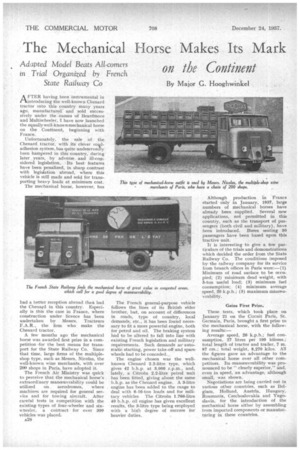The Mechanical Horse Makes Its Mark on the continent
Page 16

If you've noticed an error in this article please click here to report it so we can fix it.
By Major G. Hooghwinkel
AFTER having been instrumental in introducing the well-known Chenard tractor into this country many years ago, manufactured al sold successively under the names of Beardmore and Multiwheeler, I have now launched the equallytvell-knownmechanical horse on the Continent, beginning with France.
Unfortunately, the sale of the Chenard tractor., with its clever foldadhesion system, has quite undeservedly been hampered in this country, during later years, by adverse. and ill-consiclered legislation,. ,Its best features have been penalized, in sharp contrast with legislation abroad, where this vehicle is still made and sold for transporting heavy loads at .minimum cost.
The mechanical horse, however, has had a better reception abroad than had the Chenard in this country. Especially is this the case in France, where construction under licence has been undertaken by Messrs. Tracteurs F.A.R., the firm who make the Chenard tractor.
A few months ago• the mechanical horse was awarded first prize in a competition -for the best means for transport for the State Railway Co. Since that time, large firms of the multipleshop type, such as Messrs. Nicolas, the well-known wine merchants, with over 200 shops in Paris, have adopted it.
The French Air Ministry was quick to perceive that the mechanical horse's extraordinary manceuvrability could be utilized on aerodromes, where machines are required for general service and for towing aircraft. After careful tests in competition with the existingtypes of four-wheeler and sixwheeler, a contract • for over 300 vehicles was placed. 208
The French general-purpose vehicle follows the lines of its British elder brother, but, on account of .differences in roads, type of country, local demands, etc., it has been found necessary to fit a more powerful engine, both for petrol and oil. The braking system had to be altered to fall into line with existing French legislation and military requirements. Such demands asautomatic starting, power take-off and spare wheels had to be conceded.,
The engine chosen was the wellknown Chenard 2.2-litre type, which gives 42 ti.h.p. at 3,000 r.p.m., and, lately, a Citroen 2.2-litre petrol unit has been fitted, giving about the same h.h.p. as the Chenard engine. A 3-litre engine has been added to the range to deal with 6-10-ton loads and for military vehicles The Citroen 1.766-litre 40 b,h.p. oil engine has given excellent results, the 3-litre type being employed with a high degree of success for heavier duties. Although production in France started only in January, 1937, large numbers of mechanical horses have already been supplied. Several new applications, not permitted in this country, such as the transport of passengers (both civil and military), have been introduced. Buses seating 50 passengers have been based upon this tractive unit.
It is interesting to give a few particulars of the trials and demonstrations which decided the order from the State Railway Co. The conditions imposed by the railway company for its service from branch offices in Paris were:—(1) Minimum of road surface to be occupied; (2) minimum dead weight, with 5-ton useful load; (3) minimum fuel consumption; (4) minimum average speed, 20 k.p.h.; (5) maximum manceuvrability.
Gains First Prize.
These tests, which took place on January 21 on the Circuit Paris, St. Germain, Paris, brought a first prize to the mechanical horse, with the following results:— Average speed, 26 k.p,h.; fuel consumption, 27 litres per 100 kiloms,; total length of tractor and trailer, 7 m. 87 cm.; total weight, 8,270 kilos. All the figures gave an advantage to the mechanical horse over all other competitors. Its manceuvrability was pronounced to be " clearly superior," and, even in speed, an advantage, although small, was shown.
Negotiations are being carried out in various other countries, such as Belgium, Holland, Austria, Hungary, Roumania, Czechoslovakia and Yugoslavia, for the introduction of the mechanical horse either by assembling from imported components or manufacturing in these countries.


























